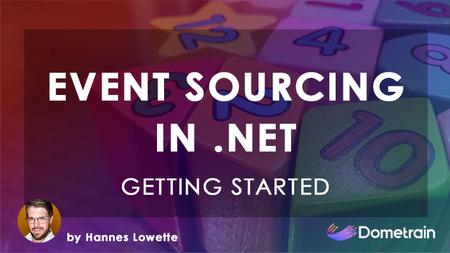English | MP4 | AVC 1920×1080 | AAC 44KHz 2ch | 45 Lessons (4h 1m) | 863 MB
Get started with Event Sourcing and CQRS in .NET
Event Sourcing is a persistence design pattern. It is often mentioned alongside CQRS and DDD. In short, it is the practice of storing the events that lead up to the current state instead of storing the state itself, as one would do in a CRUD system with a normalized database. The assumption is that it is always possible to re-create the state from the events, but not the other way around. Especially when Event Sourcing is combined with CQRS architecture, it enables a whole new way of thinking about data in your applications. It enables point-in-time data and the possibility to process old events against new features retroactively. In this course, the Event Sourcing principles and patterns are introduced, and we build an entire CQRS application from scratch to demonstrate how things piece together. We are not using a ready-made framework for this, but we are trying to take away the magic by building our own. At the end of this course, you should be familiar with event sourcing and how it fits with CQRS architecture.
Table of Contents
1 Welcome
2 What will you learn in this course
3 Who is the course for and prerequisites
4 What is Event Sourcing
5 Commands vs Events
6 Future, Present & Past
7 The relationship with DDD
8 Events, streams & aggregates
9 The command handler life cycle
10 CQRS architecture
11 Section recap
12 Introduction to our domain
13 Modelling Events & Commands
14 Value Types in commands & events
15 Making root entities
16 Building Command Handlers
17 Adding a Command Router
18 An exercise for you to make
19 Section recap (2)
20 Introduction to the test base class
21 Writing event sourced tests
22 Making our tests more read readable
23 Another exercice
24 Section recap (3)
25 What are we going to build
26 A look at our starting point
27 Building a simple event store
28 Building a command API
29 Alternate API approaches
30 Finalizing & running our API
31 Exercise time again!
32 Section recap (4)
33 Checking out the read API
34 Querying aggregate data
35 Building a projection system
36 Exercise
37 Section recap (5)
38 The typical UI pattern
39 Introducing the SignalR Hub
40 Publishing our events over SignalR
41 A final exercise
42 Section recap (6)
43 What can our system now do
44 Beyond this course
45 Conclusion
Resolve the captcha to access the links!
